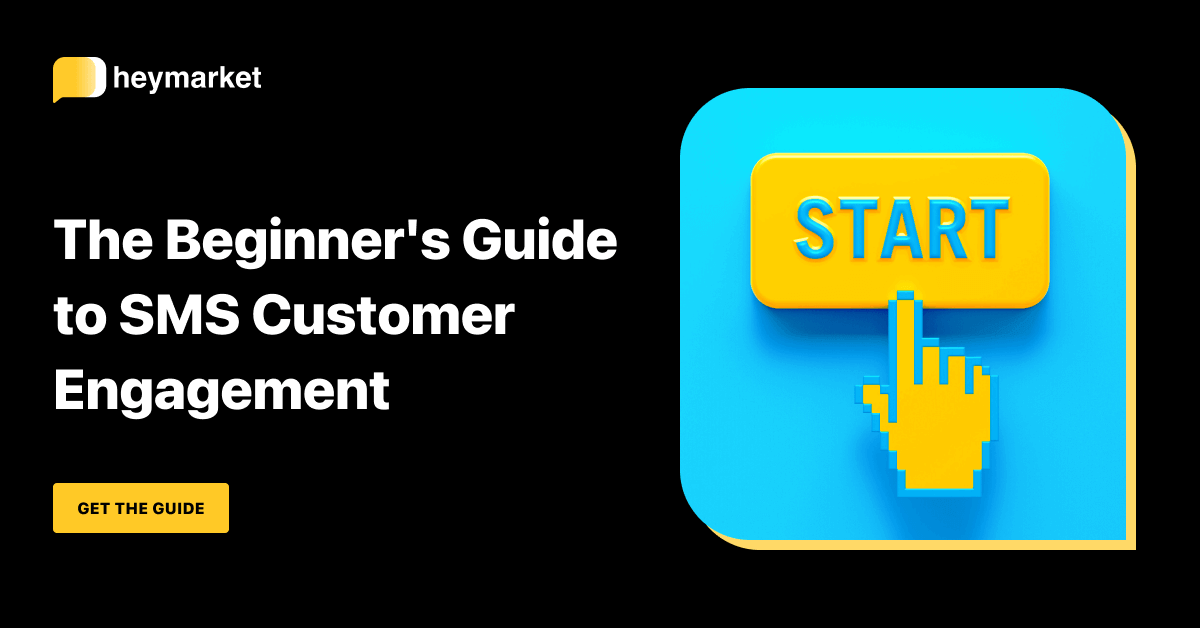
Conversational customer engagement is a new—and popular—messaging strategy. Businesses that adopt this strategy focus their efforts on customer-initiated, person-to-person conversations. Their content encourages customers to reach out and connect with their teams.
As a retail or eCommerce company, you know all about personal connections. Retail businesses, whether they’re solely online or hybrid, rely on making authentic connections with their customers. That’s why so many are adopting this new strategy.
But how does conversational customer engagement satisfy your day-to-day retail customer communication needs?

Want a step-by-step look at building strong customer relationships through texting? Read our Beginner’s Guide to SMS Customer Engagement.
Get the guideSending Order Updates
Your business probably already sends order updates. But are you treating these as an opportunity to circle in? Personalize each order update to encourage your customers to reply if they have questions.
Focus your attention on in-store purchase notifications or delivery alerts. These are great opportunities to ask customers whether their orders were to their liking. Here are two examples of order updates that adhere to a conversational customer engagement strategy:
Hello {{customer name}}, Sam from Pet Foods here. Your order #{{order#}} has been delivered. Does everything look good to you and {{pet name}}? Text STOP to stop receiving texts.
Hiya {{customer name}}, thanks for stopping by Paradise Bath Goods on {{purchase date}}! I’ve attached your receipt, as requested. Are you enjoying your purchase? Text STOP to unsubscribe. —Layla, Customer Happiness Associate
Order and purchase follow ups should provide critical information and open up lines of communication for customers. In other words, these short texts can do a lot of work.
Checking In After Returns or Tickets
Returns and customer service tickets are critical customer moments. You have to let customers who aren’t satisfied with a product know that you prioritize their experience. Conversational customer engagement content can help them know you care.
Don’t just rely on top-notch service during the return or ticket opening process. Check in again after your team receives a return or resolves a ticket. Here are two examples of post-return and post-ticket check ins that adhere to a conversational customer engagement strategy:
Hi there {{customer name}}, this is Ada from the Local Games returns department. We’ve received your return #{{return #}}! Can I help you in any other way? Text STOP to stop receiving texts.
Hey {{customer name}}! It’s Odin from Swift Software. I hope our conversation on {{ticket resolution date}} helped clear things up. Is everything working smoothly? Text STOP to stop receiving texts.
Detailed return and ticket follow ups can start conversations between your team and customers. They may let your team know that something still isn’t right—or receive your messages and feel as though they’re sure your team cares.
Sharing Expert Opinions
You can level up conversational customer engagement by offering customers access to experts via business text messaging. Invite customers to join Q&A chats regularly, if you have a product expert on staff.
How you word these invitations can make all the difference to customers. Here are two examples of Q&A invitations that adhere to a conversational customer engagement strategy:
Hi there, {{customer name}}! I’m Jenna, a stylist with Top Model Store. Need to spruce up your wardrobe? Not sure where to start? Text STYLIST to get personal advice. 👗 Text STOP to stop receiving texts.
Happy Holidays, {{customer name}}! Still looking for a loved one’s gift? Our Vintage Gift Elves are here to offer personalized advice! Text SNOW to get started. Text STOP to stop receiving texts.
Detailed, friendly invitations will encourage customers to text in and connect with your team’s experts.
Asking for Feedback
Feedback requests are a must-have for any business. A conversational customer engagement strategy prioritizes asking for feedback whenever possible, opening the lines of communication for customers.
Ask for your customers’ opinions for everything from customer service to new initiatives. They may be eager to share their thoughts. Here are two examples of feedback requests that adhere to a conversational customer engagement strategy:
Hey there, {{customer name}}. As one of Food Chain’s {{loyalty status}} customers, your opinion means a lot. Can you text back a number 1-5 that shows how you feel about our new loyalty member portal? 5 is great, 1 is not so great. Text STOP to stop receiving texts.
Hi, {{customer name}}! Quick question: we saw you attended our Author’s Speak event over Zoom. Any new books stick out to you? Let us know, and we’ll enter you into a drawing for one! Text STOP to stop receiving texts.
Customers will be happy you’re asking for their opinion. They may even start conversations based on products or improvements they’re excited about.
Ready to boost your customer engagement strategy with business SMS? Read our Beginner’s Guide to SMS Customer Engagement.





